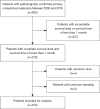Development and validation of a nomogram to predict overall survival of conjunctival melanoma: a population-based study
- PMID: 38482451
- PMCID: PMC10928613
- DOI: 10.21037/tcr-23-1277
Development and validation of a nomogram to predict overall survival of conjunctival melanoma: a population-based study
Abstract
Background: Conjunctival melanoma (CM) is a rare, invasive tumor in the eye that readily metastasizes and spreads. Based on some significant clinicopathological information, we aimed to develop a prognostic model to predict the overall survival (OS) of CM patients.
Methods: Data of patients diagnosed with CM from 2000 to 2019 were identified from the Surveillance, Epidemiology, and End Results (SEER) database. Significant prognostic factors were extracted and integrated based on competing risk regression to build a nomogram. Harrell's concordance index (C-index), receiver operating characteristic (ROC) curve, and calibration plots were used to evaluate the performance of the nomogram.
Results: The study included 272 patients with CM, with a median age of 63 years. A nomogram was developed using age and tumor-node-metastasis (TNM) stage as variables. The model's C-index was 0.755, and the area under the curve (AUC) was 0.774, 0.812, and 0.815 at 5, 8, and 10 years, respectively. The calibration plot used to predict CM demonstrated good consistency between the predicted OS probability and the actual OS probability.
Conclusions: We have developed a nomogram model to predict the OS of patients with CM, which can predict the survival of these patients. The model's prognostic value is higher than that of the American Joint Committee on Cancer (AJCC) staging system alone. This tool can help evaluate the tumor-specific prognosis, identify patients at high risk of cancer-specific death, and guide clinical decision-making.
Keywords: Conjunctival melanoma (CM); Surveillance, Epidemiology, and End Results (SEER); nomogram; overall survival (OS); prognosis.
2024 Translational Cancer Research. All rights reserved.
Conflict of interest statement
Conflicts of Interest: All authors have completed the ICMJE uniform disclosure form (available at https://tcr.amegroups.com/article/view/10.21037/tcr-23-1277/coif). The authors have no conflicts of interest to declare.
Figures






References
LinkOut - more resources
Full Text Sources
